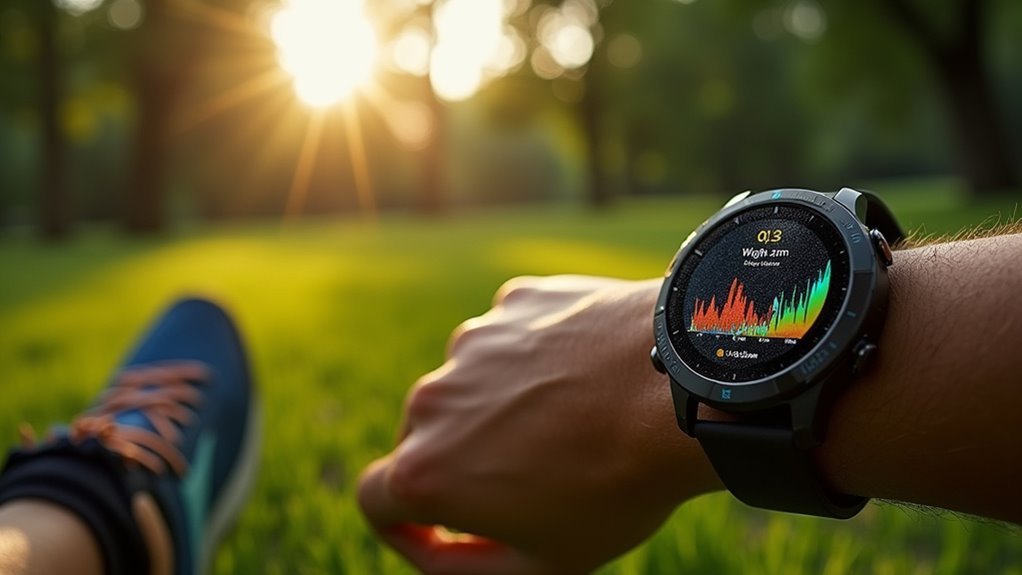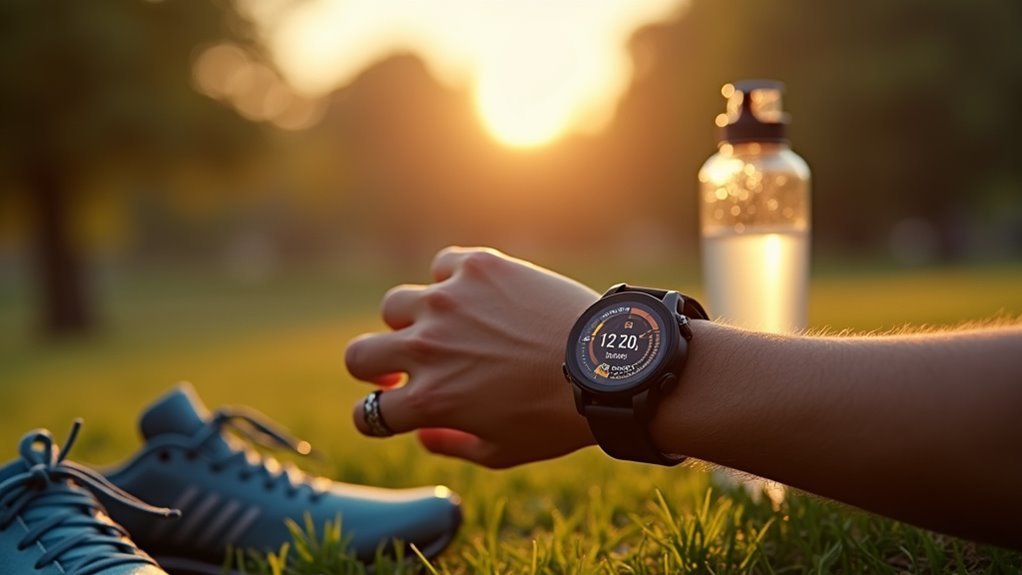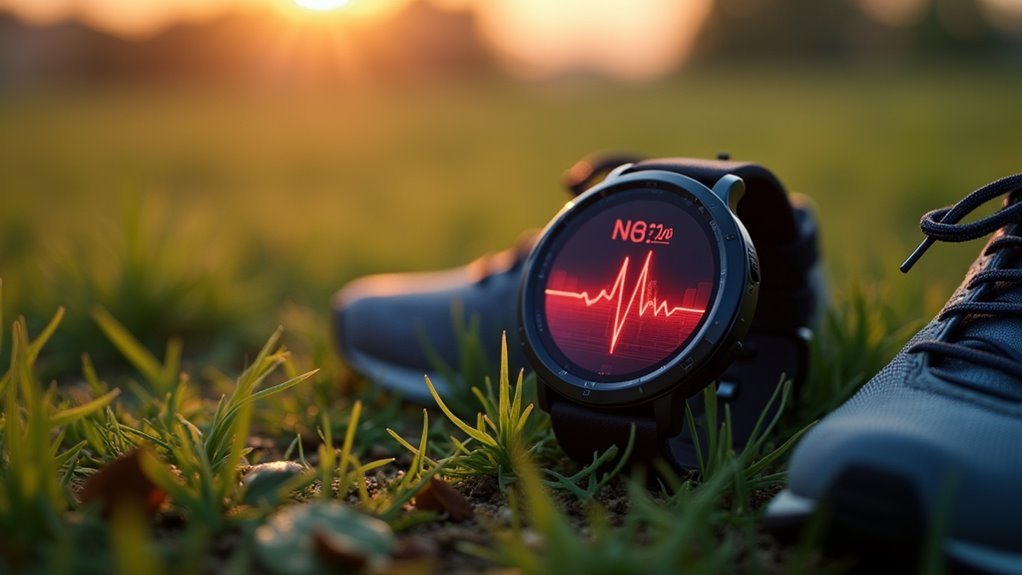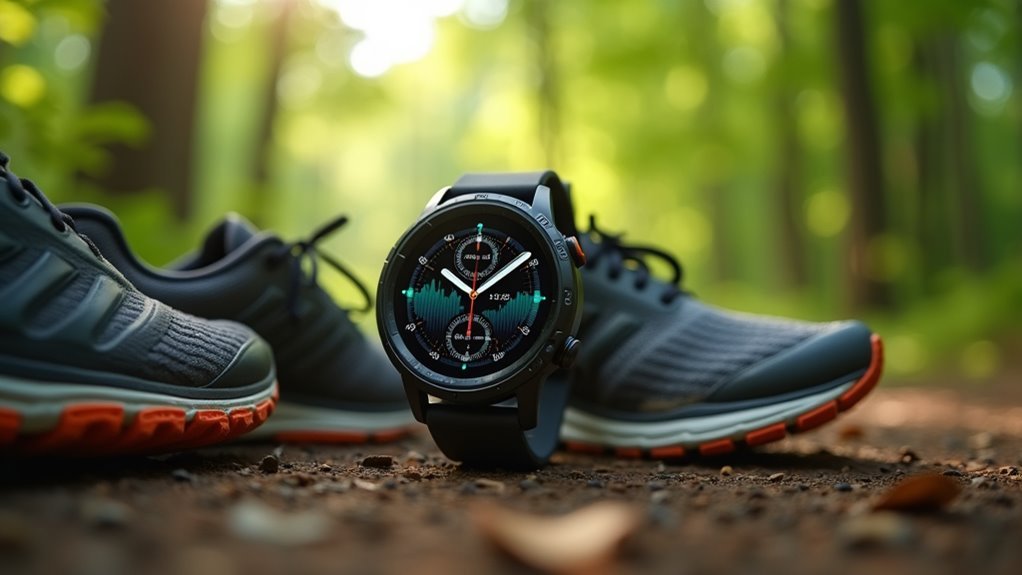You’ll optimize your running performance by tracking key recovery metrics that reveal when your body’s ready for intense training or needs rest. Monitor your heart rate variability (HRV) for nervous system recovery, resting heart rate for daily readiness, and weekly training load to prevent dangerous spikes. Real-time recovery scores from wearables provide hourly updates on fatigue levels, while VO2 max and lactate markers offer deeper insights into your aerobic capacity and recovery speed. These extensive metrics will transform your training approach.
Understanding Weekly Training Load and Its Impact on Recovery

While many runners focus solely on daily workouts, your weekly training load provides the complete picture of how exercise stress accumulates over time. This numerical value combines workout duration, intensity, and perceived exertion into a single score that quantifies your total training stress.
You’ll calculate it by multiplying your rate of perceived exertion (RPE) by session duration, then aggregating daily totals throughout the week. This metric helps you avoid dangerous load spikes that can lead to injury weeks later.
By following the 10% rule for weekly progression, you’ll prevent overtraining while ensuring adequate stimulus for adaptation. Training requires a long-term commitment for success, with resilience building over time by listening to the body to prevent injuries and burnout.
Your weekly load data enables strategic recovery planning, allowing you to schedule deload weeks after 3-4 weeks of progressive training stress.
Training Status: Your Daily Fatigue and Fitness Indicator
Beyond tracking weekly totals, your training status reveals the daily interplay between accumulated fitness and current fatigue levels. This metric calculates your form by subtracting yesterday’s fatigue from yesterday’s fitness, giving you a clear picture of your readiness for performance.
Your training status operates on two timescales:
Effective training monitoring requires understanding both short-term fatigue patterns and long-term fitness adaptations working together.
- Fatigue tracking – An exponential average of your workout effort over the past 7 days
- Fitness measurement – A 42-day exponentially weighted average reflecting your long-term training adaptations
- Form calculation – The difference between fitness and fatigue, indicating peak performance readiness
- Optimal balance – Maintaining fatigue levels between 0.8 and 1.3 for sustained fitness gains
- Strategic tapering – Reducing fatigue faster than fitness loss to improve competitive form
Understanding this relationship helps explain why consistent training typically shows fatigue rising at a greater rate than fitness, requiring deliberate recovery periods to maintain optimal performance capacity.
Real-Time Recovery Metrics: Hourly Updates for Optimal Performance

As your training intensity fluctuates throughout the day, real-time recovery metrics provide hourly updates that capture the dynamic interplay between your current fatigue levels and underlying fitness.
These metrics synthesize data from wearable devices that continuously monitor your heart rate, energy expenditure, and physical activity. Advanced algorithms process this information to deliver updated recovery scores, reflecting your remaining energy reserves and readiness for subsequent efforts.
You’ll receive actionable insights that help you fine-tune training intensity, determine when additional rest is necessary, and plan recovery strategies based on your current physiological status. Understanding these baseline metrics helps establish meaningful tracking patterns that guide deeper analysis of your recovery performance.
This real-time approach lets you adapt your daily schedule dynamically rather than following fixed recovery timelines, ultimately preventing overtraining and optimizing your performance outputs throughout each day.
Heart Rate Variability: Measuring Your Nervous System’s Recovery
When you measure heart rate variability, you’re fundamentally taking the pulse of your autonomic nervous system’s recovery status. HRV tracks the time intervals between consecutive heartbeats, revealing the balance between your sympathetic and parasympathetic nervous systems.
Higher HRV indicates you’re recovered and ready for intense training, while lower readings suggest stress, fatigue, or insufficient recovery. You’ll need consistent daily measurements—preferably at the same time each morning—to establish your personal baseline. For accurate readings, allow 2 to 5 minutes during each measurement session rather than quick spot checks.
Key HRV insights for runners:
- Individual baselines matter more than universal values or comparisons to others
- Consistent drops signal overtraining or illness before you feel symptoms
- Mental stress affects readings just like physical training load
- Several weeks of data are required for meaningful interpretations
- Chest straps provide accuracy over wrist-based devices for measurement
Resting Heart Rate as a Window Into Your Recovery State

While HRV reveals the intricate dance between your nervous systems, your resting heart rate offers a simpler yet equally powerful window into your recovery state. Your RHR typically ranges between 60-90 beats per minute, though trained athletes often see rates as low as 40 bpm.
| Recovery State | RHR Change | Action Needed |
|---|---|---|
| Well Recovered | Normal baseline | Continue training |
| Partial Recovery | 5-10 bpm above baseline | Light activity |
| Poor Recovery | 10%+ above baseline | Rest day |
| Overreaching | Consistently elevated | Extended recovery |
Monitor your RHR first thing each morning before getting out of bed. Factors like sleep quality, stress, and illness directly influence these readings, making them reliable indicators for adjusting your training intensity and optimizing recovery. Beyond daily monitoring, understanding your heart rate recovery after workouts provides additional insight into your cardiovascular fitness and autonomic nervous system function.
Post-Exercise Heart Rate Recovery: What the Numbers Tell You
Your heart rate’s journey back to baseline after a run reveals vital insights about your body’s recovery capabilities.
The speed and pattern of this decline reflects how well your autonomic nervous system shifts from high-stress sympathetic mode back to the calming parasympathetic state.
These recovery rate patterns serve as a reliable barometer for your cardiovascular fitness and overall training readiness. Research demonstrates that faster recovery rates are strongly associated with reduced risks of cardiovascular events and lower mortality rates.
Recovery Rate Patterns
How quickly should your heart rate drop after you finish running? Your recovery rate follows distinct patterns that reveal important insights about your cardiovascular fitness and health status.
Heart rate recovery occurs in two phases: a fast phase within the first minute, followed by a slower, gradual decline. The intensity of your workout directly affects how quickly you’ll recover – harder efforts naturally require more time for your heart rate to normalize.
Research indicates that the earliest recovery measurements may be the most predictive of cardiovascular health outcomes. Understanding these patterns helps you:
- Identify fitness improvements – Better conditioning leads to faster recovery over time
- Recognize individual differences – Genetics and lifestyle factors create unique recovery signatures
- Adjust training intensity – Slower recovery may indicate you need easier workouts
- Monitor cardiovascular health – Consistent patterns help detect potential issues
- Track progress effectively – Regular monitoring shows fitness gains
Autonomic System Balance
These recovery patterns reflect the complex interplay between two branches of your autonomic nervous system working to restore balance after exercise.
Your parasympathetic system kicks in immediately after you stop running, driving the rapid heart rate drop you’ll see in those first few minutes. Meanwhile, your sympathetic system remains elevated briefly—plasma norepinephrine actually peaks around one minute post-exercise before gradually withdrawing.
If you’re well-trained, you’ll notice faster heart rate recovery compared to less fit individuals, reflecting your more efficient parasympathetic reactivation.
The intensity and duration of your workout directly impact this balance: high-intensity sessions create more pronounced autonomic disturbance, while moderate efforts below your first ventilatory threshold maintain better system equilibrium during recovery. Research shows this heart rate decline follows an exponential pattern across all conditions, representing an intrinsic property of your cardiovascular system.
Pace and Performance Trends as Recovery Indicators
While traditional metrics like distance and duration provide basic training feedback, pace serves as one of the most immediate and accessible indicators of your recovery status. Your recovery runs should feel almost effortless, typically running 1-2 minutes per mile slower than your usual easy pace. This places you in training zone 1, where conversation flows naturally.
Beyond pace, extensive performance trends paint a clearer recovery picture:
- Heart Rate Variability (HRV) – Overnight measurements reveal nervous system recovery
- Resting Heart Rate – Daily changes indicate physiological stress levels
- Weekly Training Load – Accumulated fatigue from recent sessions
- Training Status – Combines fitness and fatigue for overall readiness
- Recovery Updates – Hourly metric refreshes provide timely insights
These interconnected metrics help you make informed training decisions. Your recovery percentage provides clear guidance on your current state, ranging from exhausted (0-19%) to fresh (90-100%), helping you determine whether you’re ready for intensity or rest.
Leveraging Wearable Technology for Comprehensive Recovery Tracking
You’ll need to evaluate how your wearable device integrates multiple recovery metrics into a unified dashboard that provides actionable insights rather than overwhelming data streams.
Your choice of device should align with your specific recovery tracking goals, whether that’s prioritizing sleep analysis, heart rate variability, or extensive biomarker monitoring. Understanding data trends helps identify specific recovery patterns that may indicate when your body needs additional rest or when you’re ready to increase training intensity.
The key isn’t just collecting data—it’s selecting technology that translates real-time measurements into clear guidance for your training decisions.
Real-Time Metric Integration
Modern wearable technology transforms how you track and enhance your running recovery by delivering continuous, real-time data streams that capture every aspect of your performance.
Your device integrates multiple sensors to provide instant feedback on heart rate variability, movement patterns, and recovery indicators, enabling immediate adjustments to your training intensity.
Real-time integration offers several key advantages:
- Multi-sensor fusion combines heart rate, GPS, and accelerometer data for thorough performance analysis
- Live anomaly detection identifies deviations from your normal patterns before injuries develop
- Instant feedback delivery through vibration alerts and smartphone displays guides immediate form corrections
- Target zone monitoring keeps your exertion levels within safe, ideal thresholds
- Continuous data synchronization guarantees your recovery metrics update automatically as new information streams in
The continuous monitoring capabilities enable enhanced customer satisfaction through personalized recovery insights that adapt to individual athletic performance patterns.
Device Selection Considerations
Since choosing the right wearable device directly impacts your recovery tracking success, you’ll need to evaluate several critical factors before making your investment.
Accuracy tops your priority list—reliable heart rate monitoring guarantees meaningful recovery data. Consider multi-platform compatibility if you switch between Android and iOS devices frequently.
Battery life determines consistent tracking capability. Longer-lasting devices reduce charging interruptions and data gaps. Premium models offer enhanced GPS accuracy and advanced analytics that contribute to more comprehensive recovery insights.
Budget considerations include upfront costs versus ongoing expenses. While basic fitness trackers offer affordability, premium smartwatches and specialized devices like Whoop provide advanced features but require subscriptions.
Your interface preferences matter too. User-friendly designs make daily recovery tracking effortless, while complex systems might discourage consistent use.
Balance these factors against your specific recovery goals and technical comfort level.
Lactate Accumulation and Clearance: Advanced Recovery Markers
When your muscles shift into anaerobic metabolism during intense exercise, they produce lactate as a metabolic byproduct that directly reflects your training intensity and recovery status.
Your blood lactate levels reveal specific intensity zones: 2-4 mM indicates low-intensity aerobic work, 4-12 mM signals moderate anaerobic activity, and above 12 mM represents high-intensity efforts. Blood lactate typically returns to baseline levels within 32 minutes following high-intensity exercise.
Understanding lactate clearance helps optimize your recovery:
- Active recovery accelerates clearance – Light jogging clears lactate faster than complete rest
- Optimal recovery intensity – Train at 60-100% of lactate threshold for maximum clearance
- Gender differences exist – Females typically need 56 minutes for complete clearance versus males’ 40 minutes
- Nutritional support helps – Amino acids and antioxidants enhance clearance pathways
- Recovery monitoring – Elevated lactate indicates increased fatigue requiring extended rest
VO2 Max and VLaMax: Aerobic Capacity Meets Recovery Assessment
Your VO2 max reveals how efficiently your body consumes oxygen during intense efforts, while VLaMax shows your muscles’ capacity for explosive, anaerobic power production.
Both metrics directly impact how quickly you recover between intervals and how well you maintain pace during repeated high-intensity efforts.
Understanding these two systems together gives you a complete picture of your aerobic engine and anaerobic power—essential data for optimizing your recovery strategies. Traditional VO2 max testing requires incremental increases in intensity on a treadmill over extended periods to accurately measure your maximum aerobic capacity.
VO2 Max Fundamentals
Endurance defines your running potential, and VO2 max stands as the gold standard for measuring that capacity.
You’re looking at the maximum rate of oxygen your body consumes during all-out effort, measured in milliliters per kilogram of body mass per minute (mL/kg/min).
Your VO2 max reflects how efficiently your cardiovascular system delivers oxygen and how effectively your muscles use it. The Fick equation explains this: VO2 equals cardiac output multiplied by arteriovenous oxygen difference.
Here’s what you should know about VO2 max values:
- Elite endurance athletes often exceed 90 mL/kg/min
- Sedentary adults typically range 30-50 mL/kg/min
- Alaskan huskies can surpass 200 mL/kg/min
- Values generally decline with age
- Men typically score higher than women
Your VO2 max determines training intensities and predicts performance potential. Training can improve your VO2 max scores, though trainability varies significantly between individuals.
VLaMax Recovery Insights
While VO2 max reveals your aerobic ceiling, VLaMax discloses the other side of your metabolic equation—your maximum lactate production rate. This metric determines how quickly lactate accumulates during intense efforts, directly impacting your recovery speed between intervals.
If you’ve got a lower VLaMax, you’ll recover faster from hard efforts because you’re producing less lactate. This means quicker clearance and a faster return to baseline between training bouts.
Endurance runners typically benefit from VLaMax values between 0.2-0.4 mmol/l/s, while sprinters operate at 0.6-0.9. High VLaMax not only increases energy availability for explosive efforts but also lengthens recovery time from these intense training sessions.
You can strategically train to lower your VLaMax through targeted endurance work, though significant changes require 6-8 weeks. Understanding your VLaMax helps optimize interval design and recovery periods for maximum training adaptation.
Combining Both Metrics
Although VO2 max and VLaMax might seem like independent metrics, they work together as complementary pieces of your metabolic puzzle. Your recovery patterns depend on how these systems interact, not just their individual values.
When you combine both metrics, you’ll reveal powerful insights into your training adaptation:
- Recovery speed prediction – Mathematical models using both metrics accurately forecast your lactate clearance times.
- Training balance optimization – You can strategically periodize aerobic and anaerobic sessions to avoid excessive VLaMax increases.
- Zone 2 integration – Adding aerobic work after anaerobic sessions limits unwanted VLaMax elevation while supporting recovery.
- Competition readiness assessment – Monitoring both metrics throughout training cycles reveals your specific event preparedness. Most athletes see meaningful anaerobic improvements within just 2-3 weeks of focused high-intensity training.
- Fatigue management precision – Understanding their interaction helps you manage intensity distributions across varying workout demands.
EPOC and Training Load: Quantifying Your Seven-Day Fatigue Cycle
Understanding your body’s recovery needs requires more than just tracking how you feel after a workout. EPOC (Excess Post-Exercise Oxygen Consumption) quantifies the metabolic cost of your activities, measuring energy needed for recovery processes like tissue repair. Your training load sums all EPOC values over seven days, revealing accumulated exercise stress.
Higher intensity workouts generate larger EPOC values – a 45-minute run at 75% max heart rate typically yields an EPOC around 50. Your seven-day training load fluctuates, creating fatigue cycles that determine your current status. The workout density also impacts total stress, as consecutive hard training days compound fatigue more than spacing intense sessions throughout the week.
| Status | Training Load | Recovery Action |
|---|---|---|
| Peaking | Ideal after recovery | Maintain light activity |
| Productive | Sufficient for gains | Continue current plan |
| Maintaining | Steady fitness | Add variety or intensity |
| Overreaching | Excessively high | Reduce volume immediately |
| Detraining | Too low | Increase activity gradually |
Balancing Training Intensity With Recovery Capacity
Your training intensity must align with your body’s capacity to recover, or you’ll either plateau from insufficient stimulus or break down from excessive stress.
Recovery capacity depends on multiple factors including your injury history, experience level, and available training time.
High-intensity workouts like intervals and threshold runs dramatically increase training stress while improving VO2 max and lactate threshold. However, they require careful management to prevent overtraining.
Key factors affecting your recovery capacity:
- Sleep quality – Essential for muscle repair and growth
- Nutritional support – Fuels recovery processes and performance
- Mental resilience – Built through accumulated training experience
- Recovery techniques – Foam rolling and massage reduce muscle soreness
- Training experience – Elite runners handle higher volumes than recreational athletes
Monitor your body’s feedback and adjust intensity accordingly to maintain ideal training balance. Warning signs like persistent muscle soreness or elevated resting heart rate indicate you may be pushing too hard and need additional recovery time.
Building a Multi-Dimensional Recovery Monitoring System
Effective recovery monitoring requires more than tracking a single metric—you need a thorough system that captures the full picture of your physiological and psychological state.
Combine objective measurements like heart rate variability and resting heart rate with subjective assessments including RPE ratings and sleep quality questionnaires.
Integrate external load data from GPS tracking with internal markers such as neuromuscular function tests.
Use wearable devices and mobile apps to collect real-time feedback, then employ data analytics to identify patterns and trends.
Visualization tools help you interpret complex information through charts and graphs.
This multi-dimensional approach creates feedback loops that adjust your training based on recovery status, ensuring you’re optimizing performance while preventing overtraining through thorough monitoring. Consistent tracking of these metrics allows coaches and athletes to monitor athlete progress over extended periods, revealing how recovery patterns evolve with training adaptations.
Frequently Asked Questions
How Do Nutrition and Hydration Affect Running Recovery Metrics?
You’ll accelerate recovery by consuming carbohydrates and protein post-run to restore glycogen and repair muscles. Proper hydration with electrolytes prevents cramps and maintains performance, while anti-inflammatory foods reduce soreness and expedite healing.
Can Recovery Metrics Help Prevent Running Injuries Before They Occur?
Yes, you can use recovery metrics to prevent injuries by monitoring your readiness before each run. They’ll help you adjust training intensity, identify overtraining patterns, and guarantee adequate recovery between sessions.
How Long Should I Track Metrics Before Seeing Meaningful Recovery Patterns?
You’ll notice daily changes within days, but meaningful recovery patterns emerge after 2-4 weeks of consistent tracking. For stable trends and seasonal variations, you’ll need several months of data collection.
Do Recovery Metrics Differ Significantly Between Male and Female Runners?
You’ll notice significant differences in recovery metrics between male and female runners. Women typically show faster muscle function recovery, lower inflammation markers, and less fatigue accumulation, while men experience greater performance decrements.
What’s the Minimum Cost for Effective Recovery Tracking Technology?
You can start effective recovery tracking for under $50 with a basic fitness tracker offering heart rate and sleep monitoring. Add a $35 foam roller for physical recovery tools, totaling around $85 for extensive tracking.
In Summary
You’ve now got the tools to transform your recovery from guesswork into science. Don’t rely on a single metric—combine HRV, resting heart rate, training load, and subjective feelings for the complete picture. Your body’s constantly sending signals about its readiness to perform. Listen to those signals, track them consistently, and you’ll reveal the secret to training harder while recovering smarter. Your best performances are waiting on the other side of proper recovery.





Leave a Reply